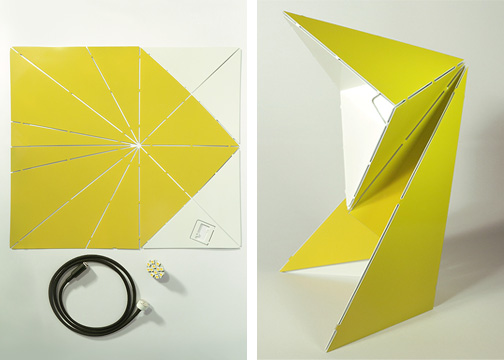
Structural Packaging and 3D form-making
We’ve came across a fascinating book by Paul Jackson (it’s one of several by him on the subject of folded forms), called “Structural Packaging: Design Your Own Boxes And 3D Forms,” – Essentially, it gives you introductory knowledge on how to create your own packaging designs. It instructs the reader how to turn 2D materials into 3D forms by using folds, tabs and closures. While it includes basic templates for nets*, ultimately the book is focused on instructing the reader on how to understand the design rules, so they can then develop their own units and packages. Many of the forms begin as basic shapes and then are manipulated – twisted, shaved, stretched or combined with other forms – to create various and complex containers. Basically, reading the book is almost like taking a mini-course on packaging design!
*(A net is essentially the unfolded, “drawn” package design – usually, there are multiple possible nets for a design, so choosing the most effective, or appropriate one is key).

(image from coolhunting.com)

(simple net design drawn by Kelsey Buzzell)
The book mainly covers forms, and only alludes to how a net may be affected by applied patterns, graphics or textures. A simple net or package (e.g. a box) can become incredibly complex when you begin to think how color or patterns move from one face to another. Other complexities are added when forms are manipulated (faces are shaved, stretched, twisted) and combined to make new shapes. Specific designs also need reinforced tabs to help hold weight, endure multiple openings or improve on the stability of the design.

(sustainable expanding bowl packaging – image from mocovote.com)
Using this book, a designer can create multiple 3D forms based on variations of cuboid, polygonal and triangular shapes. While the designs can be cut easily by hand, utilizing a laser cutter and playing around with etched surfacing and various cuts can add even more variation and design possibilities. Using this book, anyone can create custom containers for birthday and Christmas gifts, handmade products, engagement rings, party favors and hanging decorations or ornaments. Designing the right tabs and most efficient nets takes a bit of time and adjusting – but working through the process and puzzling out the options is part of the fun! Once you have created a net and design that is precise (perfect) and aesthetically pleasing, the knowledge in your success of the completion of a working design is the ultimate reward.

(Oly bracelet made from 2D paper form and a chair folded from a single piece of plastic – images from design-milk.com and goncalocampos.com)
The best part of all of this? There are endless possibilities for the creation of forms, nets and surfaces, which can inspire not only new custom designs for packaging, but also furniture, materials, lighting or products!

(Tipi, a folding furniture system – image from dailytonic.com)
Some fun videos from Paul Jackson on how to work with nets:
3. How to Create Tabs of the Correct Shape
Structural Packaging: Design Your Own Boxes And 3D Forms on Amazon


